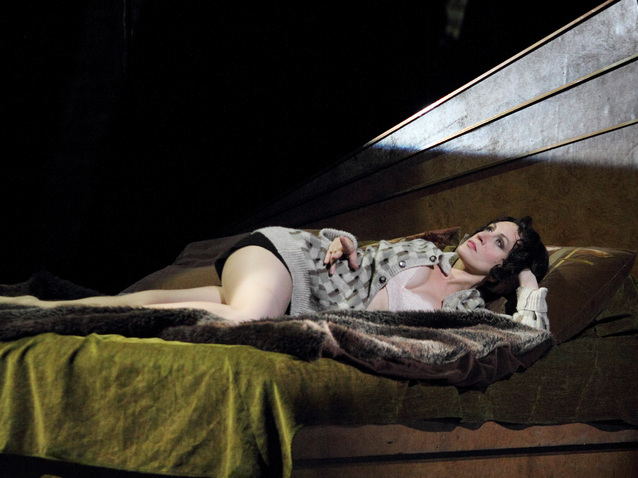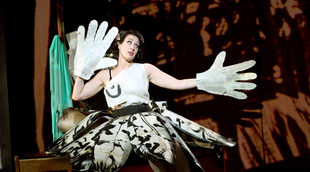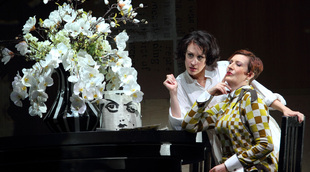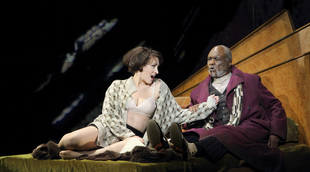 © Catherine Ashmore
© Catherine Ashmore
Philosopher and composer, Theodor W. Adorno stated that Alban Berg’s Lulu is ‘one of those works that reveals the extent of its quality the longer and more deeply one immerses oneself in it’. It was composed between 1929 and 1935 when the composer died, premiered incomplete in 1937, and in a complete version in 1979. When Berg died he left only portions of the final act fully scored, and after Arnold Schönbergdeclined to complete the orchestration, Berg’s wife Helene ruled that no-one should. It was only after her own death in 1976 that this decision could be overruled, leading to a subsequent completion by Friedrich Cerha being performed for the first time at the Opera Garnier in 1979, conducted by Pierre Boulez.

Lulu - Brenda Rae (c) Catherine Ashmore
The work is based on Frank Wedekind’s two Lulu plays, Erdgeist (Earth Spirit)of 1895 and Die Büchse der Pandora (Pandora's Box) of 1904. Erdgeist forms the basis for Act 1 and Act 2, Scene 1 of the opera, while Die Büchse der Pandora is covered by the remainder of Act 2 and Act 3.
Although the plot feels complicated, owing to the plethora of characters it involves, its basics are easy to grasp. It is the story of a femme fatale who is so beautiful and alluring that men are, quite literally, driven mad with desire for her. This leads one to commit suicide, and for her to kill another, and the manner in which she always moves on with hardly a care reveals a great callousness on her part. Nevertheless, Lulu also has her own need to be loved by them, and (although it comes across more perhaps in Wedekind’s plays) has a history of being used and abused, which explains why she can be so jealous and find it so easy to exploit others.

Lulu - Brenda Rae and Sarah Connolly
English National Opera (c) Catherine Ashmore

Lulu - Brenda Rae and Willard White
English National Opera (c) Catherine Ashmore
Despite getting away with many things, however, things ultimately go downhill for Lulu who is finally forced into prostitution to make ends meet, and is murdered when one of her clients proves to be Jack the Ripper. Her demise reveals that while she has the ability to wrap anyone around her finger who obeys any sort of societal code, she is powerless in the face of a figure who operates outside of all known boundaries.
Director William Kentridge is also an artist and delivers a brilliant new staging for English National Opera (the production has already been seen in Amsterdam and New York). He utilises many of the styles that he employs in his art anyway such as black ink on newspaper, which create aesthetically pleasing images as the print comes through between the carefully placed lines. As a result, his natural style is ideally suited to creating an Expressionist staging, an approach entirely befitting the original period in which the opera was composed. In Sabine Theunissen’s set, walls meet at angles and pile up behind each other to create a disconcerting yet visually arresting area, while light (courtesy of Urs Schönebaum)appears to shatter onto the set.
Much use is made of graphics in which Kentridge’s ink drawings on newspaper appear on screens, and feel highly reminiscent of the woodcuts of Expressionist artists Ernst Ludwig Kirchner and Erich Heckel. The images are set up to move so that in a second a newspaper can ‘fold’ over to turn a drawing of Lulu fully clothed into a nude, while we are left to question what is real and what is an image. Drawings normally reflect reality, and yet here characters wear large artificial hands and faces so that they look like the drawings of them in a visual rendering of the concept of life imitating art. Berg specifically wrote an interlude in Act 2 for a film to be displayed, and the one that Catherine Meyburgh has created is excellent as it combines Kentridge’s newspaper images with film. Some of the latter feels reminiscent of Salvador Dalí, while other parts present more exaggerated gestures that we might associate with any old silent movie. Two mute figures also act out the roles of woman (Lulu) and man (presumably all of her lovers) throughout the evening.
The production is conducted well by Mark Wigglesworth, while Brenda Rae in the title role really grows in presence and allure as the evening goes on. Berg stipulated exactly how performers should be doubled up across the various parts and there are a host of strong performances from stalwarts such as James Morris and Sir Willard White, as well as from Michael Colvin, Nicky Spence, Clare Presland and David Soar, mostly in multiple roles. Finally, Sarah Connolly is on top form as she lets her sumptuous mezzo-soprano come to the fore as the Countess Geschwitz.
By Sam Smith
Lulu | 9 – 19 November 2016 | London Coliseum
the 14 of November, 2016 | Print
Comments